

Celebrating90yearsof Blackjournalisticexcellence.


Trump’s message to abusive cops: ‘We’ve
got your back’
Fortunately, real reform continues at local levels
By Joseph Williams
hile less than
2% of policeinvolved homicides result in criminal charges, more than 280 police officers are or have served prison sentences for excessive use of force. The number has been steadily ticking upward over the last decade.
In 2020, when Louisville police gunned down Breonna Taylor during a botched raid, the incident helped galvanize the ascendant Black Lives Matter movement. Along with the murders of George Floyd and Ahmaud Arbery, Taylor’s killing spurred nationwide outrage and brought police reform tantalizingly close to reality.
How times have changed.
Five years after Taylor was killed, the only officer convict-
ed for his role in the raid was sentenced to roughly three years in federal prison. But the Department of Justice under President Donald Trump wanted him to serve just one day.
Though a judge ignored the recommendation, it marked yet another setback for police accountability and signaled that abusive officers have a friend in the White House.
From Trump’s campaign promise of immunity for police misconduct to his pardoning of two Washington, D.C. officers convicted in a fatal chase cover-up, the message is clear.
An April executive order rolling back Biden-era reforms, and the DOJ’s withdrawal from consent decrees in Minneapolis and Louisville, add to the list.
Trump’s vocal support of aggressive policing, coupled
with the ongoing drumbeat of police killing unarmed Black people, leaves many wondering whether the Black Lives Matter movement’s push for reform is already over.
But experts who study police accountability say the #BLM era is still active; just not at the federal level.
A smaller role than people think
“I definitely do not think this is the end of efforts to hold police accountable or even efforts to prosecute police officers,” says Rachel Moren, a law professor at the University of St. Thomas in St. Paul, Minnesota.
While the Trump administration appears eager to excuse police brutality, Moren emphasizes that “the federal government’s efforts to pursue police accountability are a
Robin Hickman Winfield: a life of vision and legacy
By Jasmine McBride
Associate Editor
obin Hickman Winfield describes herself not just as a filmmaker or artist, but as someone molded by community. A fifthgeneration Minnesotan with roots in both Minneapolis and St. Paul, she is the grandniece and protégé of legendary photojournalist Gordon Parks. Her life and work honor a lineage of Black excellence while offering young people a vision of possibility through storytelling, mentorship, and doll artistry.
“I am because we were,” she said. “It’s hard for me to talk about myself without talking about the village that raised me.”
Born in St. Paul and raised during her early years in Minneapolis, Hickman Winfield moved permanently to St. Paul at age five. She came of age in the Rondo and SummitUniversity neighborhoods, which she recalls as “very Afrocentric, very Black excellence oriented.” Her childhood was full of vibrant experiences, from attending J.J. Hill Elementary School with a Black principal and teachers, to visiting cultural centers like Hallie Q. Brown and the Inner City Youth League, co-founded by her father, Bobby Hickman.
“We had everything we needed: media, theater, dance, drum corps. We had options,” she said. “And our community taught us not just to dream, but to do.”
Inspired by the Black Arts Movement, the civil rights era, and her granduncle Gordon Parks, Hickman Winfield fell in love with media at an early age. She was only 16 when she began interviewing major musical acts for a teen TV show on an ABC affiliate. Before graduating high school, she had interviewed George Clinton, Bootsy Collins, and Evelyn “Champagne”

King, as well as hosting her own radio program.
That early momentum carried her to Howard University, where she pursued her dream of working in film and television. She credits her success to a combination of vision and community support. “I didn’t come from money,” she said.
“But I had people around me who helped me shape my vision and make it real.”
enue.” But Hickman Winfield’s impact extends far beyond the screen.
Her parallel creative practice is her celebrated work with dolls. What began as a childhood comfort became a form of healing and a tool for transformation. “My mother made sure we had dolls that looked like us,” she said. “And when the world felt uncertain, I found peace in that.”
Today, her “Soulful Dolls” project involves reimagining and styling dolls that reflect the beauty of Black identity.
She’s taken these creations as far as West Africa, where she gifted dolls with natural hair and Afrocentric features to girls in remote villages. “They cried,” she recalled. “They had never seen a doll that looked like them.”
Hickman Winfield sees her art as a form of ministry. “My dolls aren’t toys,” she said. “They’re healing. They’re hope.”
For more than 30 years, she has also mentored youth through media, education, and the arts. In the 1990s, she helped birth “Don’t Believe the Hype,” a groundbreaking youth-produced television program at Twin Cities PBS. The program ran for 10 years and was revived under her leadership just a few years ago, until it was recently cut due to funding reductions.
“It doesn’t necessarily require that things be equal, like dollar for dollar, but it does have to be equitable.”
Her media career has included producing a documentary for HBO about her granduncle Gordon Parks and working on the acclaimed HBO miniseries “Laurel Av-
“That was hard,” she admitted. “But we built something special, and no one can take that from us.”
She currently co-teaches
■ See HICKMAN on page 5
Most police prosecutions, she explains, happen at the state level, where charges like murder, manslaughter, or reckless homicide are more likely to be brought. “Typical
ly, officers are almost always prosecuted [federally] for
rights violations, and those are hard to prove.”
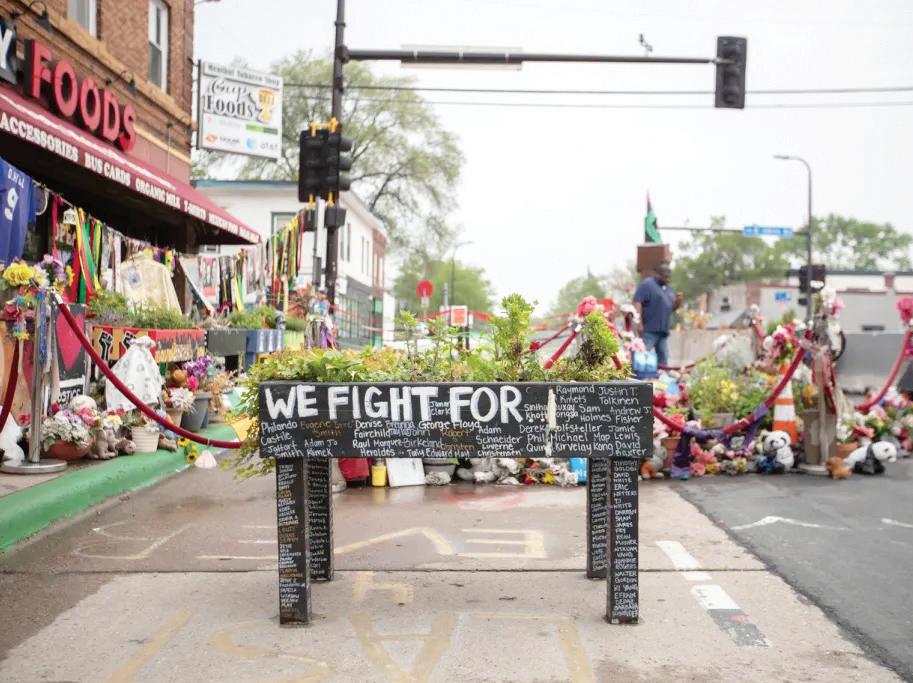
End gun violence before more children die
Frequently throughout 2025, space in these pages will be given to organizations working to end racial injustice across the state. We hope that these reflections spark policy changes for a more equitable Minnesota. This week’s guest contributor is Shanasha Whitson, founder of Mothers Against Gun Violence (MAG).
By
here is a club that no one asks to join — yet every day, mothers, fathers, and loved ones are being forced into it. There are no perks, points, free coffees or rewards. This club comes only with heartbreak: stomachaches, migraines, numbness, anger, and the crushing weight of helplessness. It brings anxiety, fear, and the isolating sense that no one else can truly understand. I know, because I’m in this club.
On May 28 I sat down with Tatiana Kilgore, the mother of 18-year-old Amarie Alowonle. Amarie was shot in the head on May 4, 2025, while at Sanborn Park in Robbinsdale. She was not in a gang. She was not the intended target. She was an innocent bystander, and as of today, no arrests have been made in her case.
Tatiana is now a member of this heartbreaking club, alongside parents like those of Trinity Ottoson-Smith. While Trinity’s killer, Dpree Robinson, was sentenced to over 37 years in prison, Amarie’s killer remains free.
“Minneapolis, we have a problem, and it cost my daughter her life,” Kilgore told me. “Our community is being flooded with illegal weapons, switches that turn handguns into fully automatic killing machines. Children are walking around with military-grade firepower. What has been the response of law enforcement? What about our elected officials?
demand justice. To the police department: Help us find Amarie’s killer. To elected officials: Declare switches a public crisis and outlaw them city by city. To the media: Shine a light on these stories — our children are not disposable. To community leaders: Stand with us. Demand action.
Amarie’s life mattered. She had dreams, value, and a future.
We’re calling on city leaders, law enforcement, and the media to publicly address this case. We are also urging national attention on the spread of “switches” — devices that make handguns fully automat-
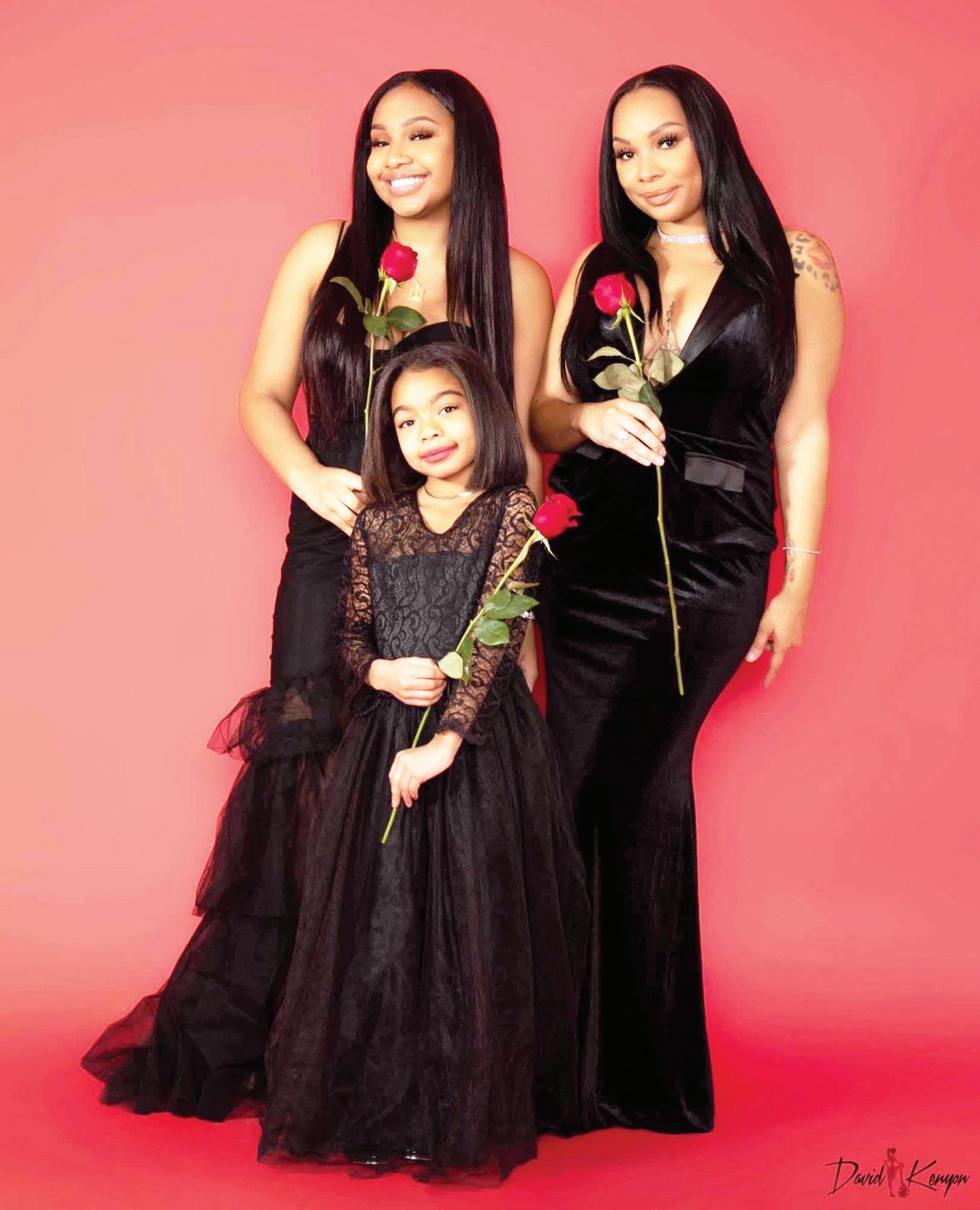
“Amarie wasn’t just the victim of a stray bullet. She was the victim of a failed system, one that refuses to address the root causes of gun violence and the communities left reeling in its wake.” We demand answers. We demand accountability. We
ic — and the devastating lack of urgency in stopping them. We will not rest. We will not be silent. We will not stop until there is justice for Mari.
#JusticeForMari
#MinneapolisDoBetter #StopTheSwitches
pretty small piece of the overall accountability picture.”
-
civil
Thaddeus Johnson, a criminal justice professor at Georgia State University, agrees. States, ■ See BLM on page 5
Chicago and 38th, where a Minneapolis memorial honors lives lost to police violence, notably George Floyd
Photo courtesy of Chris Juhn/MSR
Robin Hickman Submitted photo
Shanasha Whitson
(l-r) Amarie Alowonle, Amarie’s little sister, and her mother, Tatiana Kilgore
Health
Lead’s toxic legacy
Though
banned, lead is still poisoning Black kids in schools
By Quintessa Williams
Dionna Brown was two weeks shy of her 15th birthday when her world turned upsidedown. An outstanding public high school student in Flint, Michigan, with a report card most of her peers would envy, she suddenly began to struggle in the classroom for no obvious reason.
“I was in AP and honors classes — straight-A student,” she recalls. “Then all of a sudden I couldn’t remember things. I couldn’t concentrate.”
Rushed to the hospital, doctors pinpointed the problem: Tests revealed elevated levels of lead, a potent neurotoxin, in Brown’s blood. In high enough concentrations, lead can cause permanent brain damage, lower IQ, learning disabilities — and even death.
portionately high levels of lead exposure in schools.
“Once a child is exposed to lead, the impacts are irreversible,” says Dr. Denae King, associate director of the Bullard Center for Environmental and Climate Justice at Texas Southern University. “There’s not a lot you can do to undo that damage — and it’s still happening.”
These cities share more than aging infrastructure: They also serve large Black K-12 student populations, often in racially segregated neighborhoods. And even Flint, whose water crisis made national news, still hasn’t fully established safe drinking water for its children.
While Milwaukee’s crisis may feel like the beginning for some, the poisoning of Black communities by lead — especially in schools — began long
early lead exposure. The report found that exposure was linked to significantly lower standardized test scores in fourth-grade reading and math compared to their white peers.
“Most of the Black kids we’re talking about attend schools built before the ban,” King says. “That means many of them are still walking into buildings that are not only failing structurally, but failing them academically, too.”
The educational cost
King explains that the root of the lead crisis in schools often begins underground, with lead service lines — city-owned pipes that deliver water from municipal systems to homes, businesses and schools.
“Most cities still have lead service lines,” she says. “So it’s no surprise students are being

Without knowing it, Brown became one of the many young victims of the Flint water crisis. But her story is being repeated in cities across the country.
For generations, America’s crumbling infrastructure has quietly poisoned its most vulnerable populations. From peeling paint in public housing to unsafe water pipes beneath city streets, lead has lingered long before and after its federal ban in 1978.
But while the government has taken action against lead exposure in homes, experts say its impact in our schools remains overlooked.
In January the issue made headlines again when a child attending a Milwaukee public school tested positive for elevated lead blood levels. The discovery triggered emergency inspections and forced at least four other schools in the district to close temporarily.
Subsequent data found that children in cities like Cleveland, Detroit, Philadelphia, Baltimore and Chicago also face dispro-
before 2025.
Today, Brown, now the national youth director of Young, Gifted, & Green, a nonprofit organization, has spent years fighting for environmental justice. But what still haunts her the most is how little has changed.
“That was over a decade ago,” she says. “And we’re still here. Kids are still being poisoned in our schools and communities.”
Schools built to fail?
Nationwide, more than 38% of public K-12 schools were built before 1970, well before the government banned the use of lead-based paint. Many of the schools were built to serve Black students in underfunded, segregated neighborhoods, and these aging buildings often contain lead service lines, contaminating the water that flows into cafeteria faucets and hallway water fountains.
According to a 2022 study in the Proceedings of the National Academy of Sciences, Black children face higher levels of

sources are underfunded or absent altogether.
Who’s accountable?
Cleveland, Ohio, currently leads the nation in childhood lead exposure, with more than 8% of children younger than age 6 testing positive for elevated blood lead levels. The Cleveland Metropolitan School District (CMSD) serves a student population
exposed.” She adds that even if a school updates its internal plumbing, “students remain at risk” if city pipes aren’t upgraded.
According to the Centers for Disease Control and Prevention, even low levels of lead exposure in children can cause irreversible damage, including reduced IQ, learning disabilities, developmental delays, and behavioral problems.
“The data is very consistent when we think about learning and cognitive ability with lead exposure in children ages zero to six,” King adds. “By the time you get to first or third grade, you start to see the results of that early exposure.”
Just as striking as the exposure itself is the uneven response. In wealthier districts, King says, active parentteacher organizations (PTOs) can quickly raise money for water filtration systems. Unfortunately, that’s not the case in predominantly Black or low-income communities, where PTOs and other re-





will center our survival,” said Dionna Brown. However, both King and Brown say the problem is nuanced.
“There are different levels of accountability that include the municipality and homeowners,” King says. “But on the school side, they are responsible for ensuring their campuses are safe. You send your child to school expecting they’ll be protected, not poisoned.”

that is 64% Black.
When asked about lead in students’ blood, CMSD told Word In Black they’re “concerned” about the health hazard and will “continue to strongly support the work done by the City of Cleveland and the Lead Safe Coalition to identify and remediate lead in our neighborhoods.”
While the school district did not directly address the problem, Dr. David Margolius, the city’s director of public health, says school systems aren’t entirely to blame.
“This is the fault of the generations of disinvestment in housing and public infrastructure in poor communities — which leads to exposure in the first place,” he says.
“We need reparations — full stop. We need healing, investment, and policy change that
She adds that parents are often left in the dark. “Many parents have shared that they are concerned that their children are not learning at the same level as other students in their classes,” she says. “And I am surprised that schools don’t do a better job of educating parents about the risk of lead exposure and that they don’t provide wraparound services once a child has been exposed.” Brown agrees: “Schools still have a responsibility. Kids spend 8-plus hours in school buildings every day.”
Moreover, federal programs intended to address the crisis have faltered. While the Biden administration’s Infrastructure and Jobs Act was designed to fund the replacement of lead service lines, access to the resources remains inconsistent
across cities, often leaving underfunded and de facto segregated school districts behind.
“There’s no agency that owns the problem,” Margolius adds. “There’s no one taking ownership for how to fix this at the federal level. That’s the real issue.”
Making matters worse, the CDC recently laid off its entire childhood lead poisoning prevention staff, shifting responsibility to the newly formed Administration for a Healthy America under Health and Human Services Secretary Robert F. Kennedy Jr. Experts are concerned about whether the federal government is prepared to meet a crisis of this scale.
Communities as first responders
Houston offers a glimpse of what’s possible. There, the Bullard Center and community groups are training parents and neighborhood leaders to identify lead hazards and demand answers from school officials.
King also encouraged students to write letters to the district. She said systems have begun to respond.
Community groups “did all the education themselves,” she says. “We trained them on what lead looks like, how it’s affecting their children, and then they got out there and educated others. The community stepped up where the system failed.”
Back in Cleveland, Margolius hopes to see a similar momentum, but on a national level. “Keeping these stories alive in the media and community discussions is essential. Without sustained attention, the crisis will quietly continue.”
This piece was originally published in Word in Black. For more information, visit www.wordinblack.com.
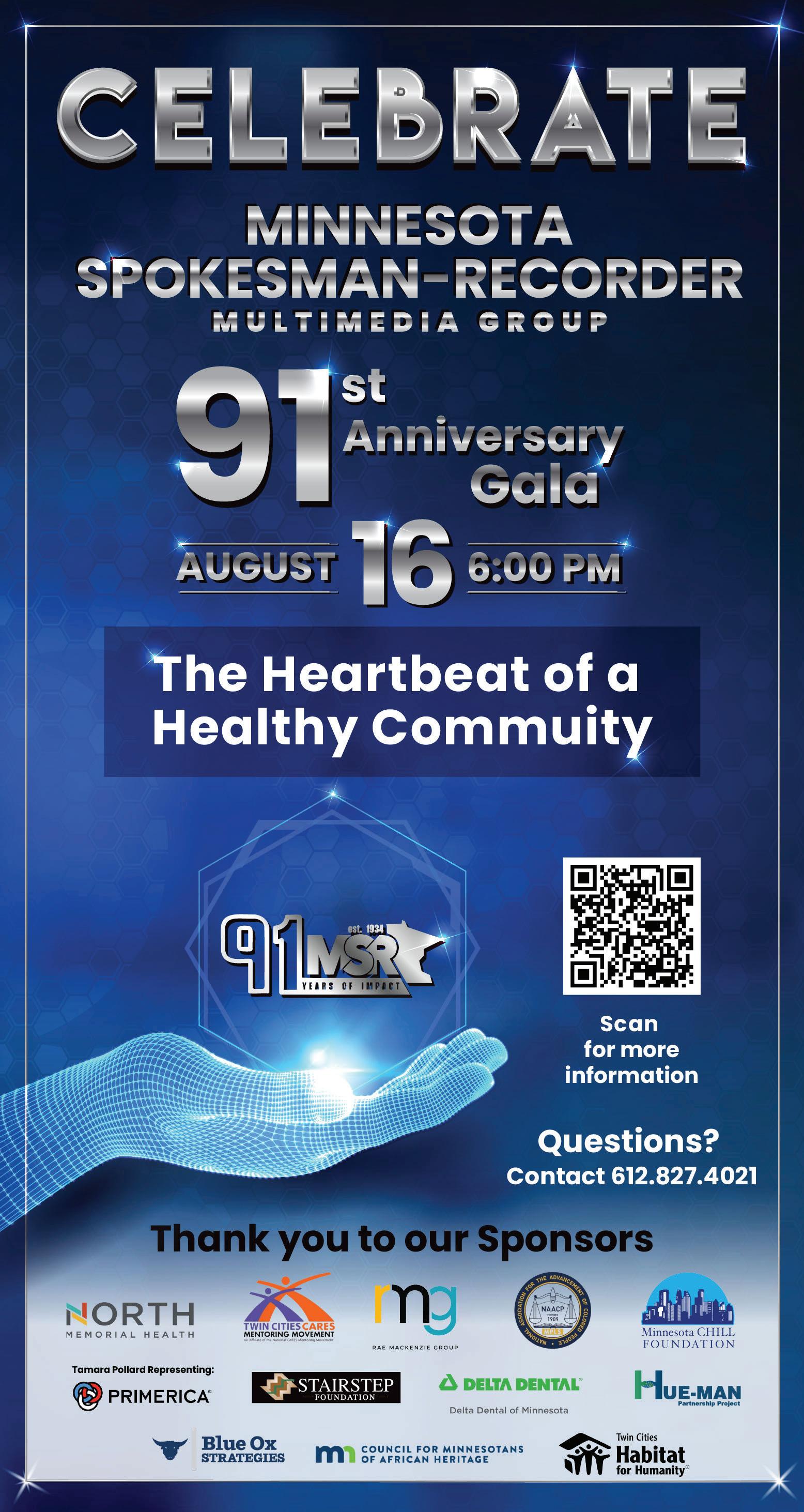
Above, the graph depicts the percentage of children aged under 6 years old with elevated blood lead levels in 2022 according to Drexel University’s Urban Health Collaborative.
Above, a closed grade school’s water fountain (Al Seib / Los Angeles Times)



By Jasmine McBride Associate Editor
As debates around public safety, surveillance, and community trust continue across the country, a growing number of cities, including Minneapolis, are turning to technology to address persistent gun violence. ShotSpotter, a gunfire detection system developed by California-based SoundThinking, is currently deployed in more than 170 cities nationwide.
In an interview with the Minnesota Spokesman-Recorder, SoundThinking CEO Ralph Clark defended the company’s role in combating gun violence, particularly in Black communities that continue to be disproportionately impacted by firearm-related deaths.
“ShotSpotter is an unbiased, agnostic system,” Clark said.
“Unfortunately, historically underrepresented communities suffer most from gun violence. This technology ensures every gunshot gets a response, no matter the ZIP code.”
How the technology works
ShotSpotter relies on a network of acoustic sensors installed across designated neighborhoods. When the sensors detect what may be gunfire, the incident is verified by trained audio analysts before an alert is sent to law enforcement, typically within 60 seconds. That alert includes the precise location, time, number of rounds, and other situational details.
Clark noted that unlike traditional emergency calls, which rely on witnesses to report gunshots and estimate locations, ShotSpotter functions in real time and fills the gap in underreported incidents. “It’s a documented fact that less than 20% of gunfire is reported through 911 in some of our most vulnerable communities,” he said.
Equity in deployment
Black Americans make up just 14% of the U.S. population but account for 60% of firearm homicide victims, according to SoundThinking.
The company positions its product as part of the solution to that disparity. Clark, a Black executive who grew up in East Oakland, said his own lived experience shapes how he views ShotSpotter’s role in transforming public safety institutions.
Business
Gunfire detection tech raises concerns of

necessarily invalid, and it’s exactly why we put strict guardrails in place,” he said.
“ShotSpotter detects gunfire, not people. It initiates a response. What happens next depends on how law enforcement uses the information.”
He added that cities involving community voices early in the process tend to see better outcomes. “We support that,” he said. “Transparency sharpens us.”
Impact and the road ahead
SoundThinking points to a 2024 study by the University of Chicago Crime Lab that estimated that the technology could help save about 85 lives annually in Chicago by accelerating emergency response.
Clark cautioned against false choices between technology and community-based investments. “We need both upstream investments and immediate response,” he said. “One stops the cycle; the other stops the bleeding.”
Looking ahead, SoundThinking says it is evolving beyond detection to include tools that support data-informed community safety planning. Clark emphasized that no technology is a standalone solution, but it can be part of a more responsive and equitable approach to public safety.
“No technology should operate apart from the people it serves,” he said.
SoundThinking’s recently released 2024 ESG (Environmental, Social, and Governance) report further outlines the company’s stated commitment to diversity, equity and inclusion. The report emphasizes transparency, community engagement, and the use of independent evaluations, including privacy reviews by
the NYU Policing Project and oversight by local privacy commissions, as part of the company’s operational framework.
The ESG letter describes ShotSpotter as a tool intended to equalize public safety response in underserved communities. According to the report, SoundThinking engages regularly with residents, clergy, and trauma-response advocates to ensure the technology is grounded in community feedback, not just law enforcement strategy.
Balancing safety and surveillance
Still, critics say the tool may have unintended consequences. Civil rights organizations and community advocates have raised concerns about its accuracy and potential to contribute to over-policing in majority-Black neighborhoods. Studies in cities like Chicago have questioned the frequen-

cy with which ShotSpotter alerts lead to arrests or the recovery of firearms.
Clark acknowledges those concerns. “That fear is not
“Time is tissue,” Clark said, referring to the crucial role of timing in trauma care.
When asked how ShotSpotter fits into long-term violence prevention strategies,
For more information, visit www.soundthinking.com.
Jasmine McBride welcomes reader responses at jmcbride@ spokesman-recorder.com.







SoundThinking CEO Ralph Clark Photos courtesy of SoundThinking
he says, are “where reform happens,” even though they’re often left out of the conversation because police abuse is framed as a national crisis.
“Only about 1.6% of police homicides end up getting prosecuted, so it’s a very small percentage,” Moren notes.
“But on the other hand, it’s more than some people think. There are 281 officers that have been prosecuted for onduty homicides in this 10-year period.”
Growing accountability
Although around 1,000 people die at the hands of police each year, the number of officers being held accountable is rising. Moren, who has studied a decade of data, says the trend line is slow but moving upward.
“Still,” she adds, “there’s no doubt Trump has wrapped the
Black Lives Matter movement and police reform into his so-called war on ‘wokeness.’”
Both Moren and Johnson say the DOJ’s resistance to police accountability under Trump, along with the former president’s public endorsement of excessive force, is likely to have real consequences.
A dangerous federal stance In April, Trump issued an executive order to “unleash high-impact local police forces” and protect officers “wrongly accused and abused by state or local officials.” The order vowed to ensure that police focus on ending crime, “not pursuing harmful, illegal race- and sex-based ‘equity’ policies.”
Just months earlier, Trump pardoned two Washington, D.C. officers convicted for their roles in a 2020 chase that left a young Black man on a moped dead. The officers also attempted to cover up their involvement. These actions, the professors say, send a chilling message to abusive
HICKMAN
Continued from page 1
a Gordon Parks Legacy class at Gordon Parks High School and leads a youth program called “Loving the Skin I’m In,” inspired by Sharon Flake’s
COMMUNITY
Continued from page 1
#ProtectOurChildren
#HoldTheShooterAccountable
Now let’s talk about the broader problem.
In connection with the killing of Trinity Ottoson-Smith, 26-year-old William Burton faces federal charges for illegally purchasing 41 handguns between November 2019 and August 2020. By April 2025, at least 17 of those guns had been recovered by police in connection with criminal activity. One of those firearms was used in the fatal shooting of 6-year-old Aniya Allen.
novel of the same name. The initiative focuses on helping girls of color embrace their identity and self-worth. Through it all, faith is Hickman Winfield’s foundation. She references scriptures often and finds strength in the idea that her work is part of a divine calling. “I believe God is saying to me now: Well done.
cops: We’ve got your back.
At a May 2024 rally in Wisconsin, Trump doubled down, promising to restore “police power” and grant officers immunity from prosecution.
“Does it suck? Yes, it sucks,” Johnson says, “because it will almost certainly cause harm.”
The administration, he believes, is essentially encouraging officers who are already prone to use excessive force.
An exception to the rule
The DOJ sparked outrage when it recommended that Brett Hankison, the Louisville officer involved in Taylor’s death, serve just one day in prison. Hankison had been tried in federal court under the Biden administration af-


ter Kentucky prosecutors declined to bring charges. A judge ultimately sentenced him to 33 months, ignoring the Trump-era DOJ’s recommendation.
But Moren sees the Han-
“The success of the movement lies with state and local activists who likely weren’t pushing the federal government anyway.”
Not perfectly done, but well done,” she said through tears. After decades of pouring into others, Hickman Winfield is now turning inward. She speaks with excitement about making more films, walking red carpets, and returning to creative work that feeds her spirit. But the greatest joy in her life right now is her hus-
band, Steven.
“That’s my blessing,” she said. “My joy, really.”
As she continues to create and uplift, Robin Hickman Winfield remains a living archive of Black history, art and resilience — proof that visionary work rooted in community can ripple through generations.
“I’ve walked the red carpets,

That leaves 24 guns unaccounted for, still out there. How many more children have to die before we act?
While specific data on how many children have been lost to gun violence in North Minneapolis between 2020 and 2025 is limited, organizations like the Gun Violence Archive can offer broad insights. But we need local data. We need transparency. And most of all, we need solutions.
So what can we do?
We teach our children healthier ways to resolve conflict. We follow the lead of cities like Baltimore, where Mayor Brandon Scott has led a historic drop in crime. Homicides are down 22%, nonfatal shootings down 19%, and ju-
kison case as an outlier. “The federal government doesn’t step in as often as perhaps some people imagine,” she says. His conviction “is one of a very small number of cases where the federal government chose to prosecute and was successful, where the state either wasn’t successful or didn’t prosecute.”
The real reformers
For Johnson, the future of police reform doesn’t rest with Washington. “The success of the movement lies with state
and have paused many times to wrap my arms around young people,” she said, referring to the West African term ‘Sankofa.’ “Now it’s my turn to return to the spotlight again.
I’m ready to rise.”
For more on Robin Hickman’s Soulful Dolls, visit www. celebrationofsoulfuldolls.com.
venile homicide victims down 71% as of mid-2025. We remove drugs from our communities and invest in real economic opportunities. We create pathways that lead away from violence through mental health access, after-school programs, trauma-informed care, and education.
“We can heal. We can protect our youth. But only if we act.”
We can heal. We can protect our youth. But only if we act.



and local activists who likely weren’t pushing the federal government anyway.”
Those activists are focusing on solutions like creating police accountability boards, hiring progressive police chiefs, and investing in social services to address root causes of crime. These approaches, Johnson says, help enhance public trust.
“They boost the legitimacy not just of police,” he says, “but of the entire local government.” Still, Johnson emphasizes that success ultimately depends on whether communities and local prosecutors are willing to treat police brutality like any other serious crime.
“As citizens, we hold [police] accountable,” he says. “That’s where the real power is.”
This piece was originally published in Word In Black. It has been edited for length and to reflect a change in photo. For the original version, or more information, visit wwww.wordinblack.com.
Despite “Don’t Believe the Hype,”executive produced and co-created by Hickman, being cut due to the current administration, you can still check it out here, www.tpt. org/dont-believe-the-hype.
Jasmine McBride welcomes reader responses at jmcbride@ spokesman-recorder.com.
There are many community-based programs across the Twin Cities offering support for families and youth. Let’s shut “The Club” down, permanently.
Shanasha Whitson is the founder of Mothers Against Gun Violence (MAG). For more information, contact cpc@cpcmn.org or call 612-481-3577.
Help is Here is a partnership between MSR and Hennepin County created to highlight local organizations committed to the recovery and education of the Black community surrounding addiction. For more information, visit our website at www. spokesman-recorder.com under the tab “Help is Here.”

#BLM activists like Marques Armstrong continue holding cops accountable for bad behavior. Submitted photo
Tatiana Kilgore (l) and her daughter Amarie Alowonle, lost to gun violence at the age of 18




By Shanasha Whitson
This week’s “Profiles In Power” features Nassir Scroggins, the youth outreach director for Community Partnership Collaborative 2.0 (CPC). A recent graduate of Norfolk State University, an HBCU, Scroggins is spearheading an Anti-Hate/Anti-Bullying Campaign funded by Hennepin County — and taking it to the next level.
tional anti-bullying messages; it’s a catalyst for skill-building, leadership development, and community healing. Through it, young people learn how to resolve conflicts, manage peer pressure, and address issues like sexual exploitation and substance use.
Scroggins’ curriculum is rooted in evidence-based models like the Olweus Bullying Prevention Program. But it’s his culturally responsive approach and youth-centered lens that make the campaign so impactful. He believes today’s youth must be empowered with tools to not only protect themselves, but also advocate for others.
The campaign includes two components: community pop-ups and structured symposiums. Pop-ups take place at events like Juneteenth and Rondo Days, while sympo-
safety, and well-being.
“This is about self-preservation,” says Scroggins. “Social justice isn’t just about police brutality. It’s also about helping young people feel safe, valued and protected in their schools and communities.”
Students engage with the campaign through arts-based projects: posters, bracelets, murals, and social media messaging designed to promote kindness and unity. Youth participants also gain a better understanding of their rights.
Scroggins emphasizes that bullying can cross legal lines. Harassment based on race, gender, disability, or national origin can be a civil rights violation. Physical violence may amount to assault. Sexting involving minors has even led to criminal charges.
collections in the country. The survey revealed that of 9th and 11th graders who had ever had sex, 203 students reported six or more partners in
the past year. Others reported high numbers as well. These findings point to complex issues of self-esteem, peer pressure,
and access to sexual health education.
In his role, Scroggins equips youth with strategies to emotionally regulate their behaviors and navigate peer challenges. The campaign he’s designed goes beyond tradi-
siums are two-hour sessions for grades 4–12. Both offer practical tools to reduce bullying, improve peer relationships, and foster critical conversations about justice,
Research supports the need for this work. A 2020 review published in “Aggression and Violent Behavior” found that Black, brown and immigrant youth are disproportionately affected by bullying, often due to adverse community and school environments. These youth are more likely to both experience and perpetrate bullying, and to face long-term health consequences as a result.
Additional insights come from the 2022 Minnesota Student Survey, one of the longest-running youth data


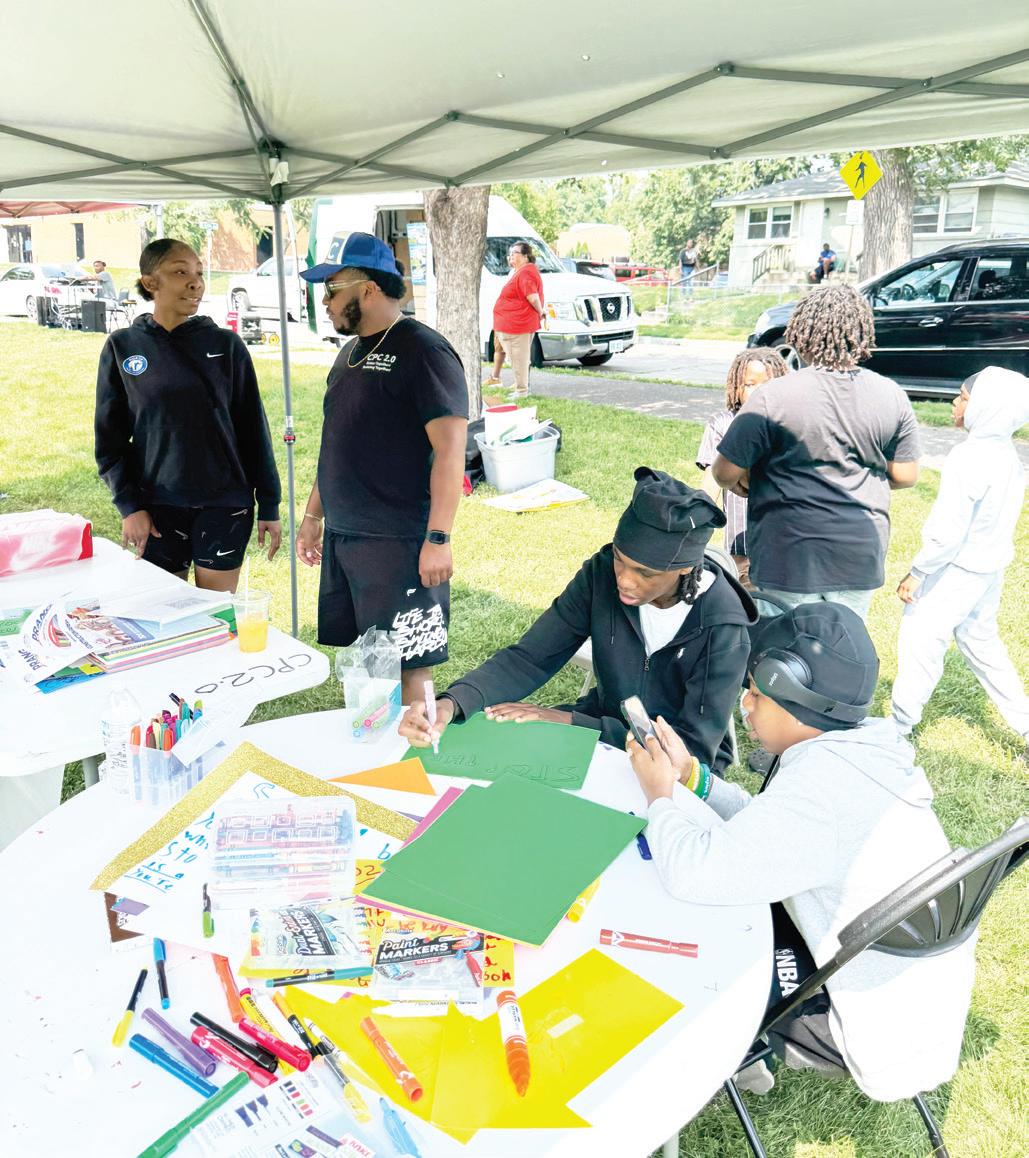
Scroggins’ campaign addresses those root causes head-on. “It’s about helping youth understand their worth,” he says. “When young people feel seen and supported, they make better decisions.”
At its core, this initiative is a village effort, an invitation for families, educators, and faith leaders to work together to raise healthy, whole children. “When we bully or perpetuate hate,” Scroggins adds, “we continue the same cycles of trauma that have historically harmed our community.”
To get your classroom, church, youth group, or organization involved, contact Nassir Scroggins at 612-423-9522 or email cpc@cpcmn.org.
Shanasha Whitson’s “Profiles in Power” aims to highlight community members spearheading positive impact in the local Twin Cities community. She is also the founder of Community Partnership Collaborative 2.0 (CPC).






Arts & Culture
By Jasmine McBride Associate Editor
In a powerful collaboration spanning generations and geographies, Grammy Awardwinning ensemble Sounds of Blackness has released a new single titled “WE’RE UNSTOPPABLE” featuring powerhouse vocalist Jamecia Bennett, the Minneapolis-based sibling band NUNNABOVE, and the energetic Atlanta Drum Academy.
Described as an “anthem for the movement,” the song officially dropped on July 25 and is available on all major streaming platforms, with a video live on YouTube.
“WE’RE UNSTOPPABLE soulfully interweaves R&B, gospel, worldbeat and classical elements into one exhilarating record,” said Gary Hines, longtime music director and founding member of Sounds of Blackness. “With heartpounding urban rhythms, all involved are at their absolute best, creating a musical experience resonating with power, hope and victory.”
The track was written, produced and arranged by Hines and recorded, mixed and mastered at Atomic K Studios in Minneapolis by Karl Demer, with additional recording support from Todd Fitzgerald and Marcus Hawkins in Atlanta.
“This is not just a song, it’s a statement,” Hines said. “We wanted to create something that speaks to the spirit of resilience and hope, especially for the youth who have always been the driving force behind social movements.”
who have appeared as finalists on “America’s Got Talent,” and the Atlanta Drum Academy, a dynamic youth-led percussion group who’ve collaborated with Beyoncé and Rihanna, contribute to the anthem’s vibrant sound.
“We needed this to be youth-driven and youthfocused because historically the vanguard of the movement has always been students, young people,” Hines said. “From the Freedom Rid-
“We wanted to create something that speaks to the spirit of resilience and hope, especially for the youth who have always been the driving force behind social movements.”
The song’s collaborators reflect this focus on youthdriven energy. NUNNABOVE,
ers to the marches of the civil rights era, young people have always led the charge.”





Jamecia Bennett, who cowrote the song, brings her signature gospel-influenced vocals, building on her family’s deep musical legacy and strong ties to the Twin Cities music scene.
The song follows Sounds of Blackness’ previous single “Thankful,” which honored Amir Locke, the 22-year-old killed by Minneapolis police in 2022. “Thankful” received nominations from both the NAACP Image Awards and the International Songwriting Competition.
Formed at Macalester College in 1969 as the Macalester College Black Choir, Sounds of Blackness officially became in 1971 the group it is known as today, making this their 54th anniversary year. Known for their genre-defying sound, the group draws from every corner of the African and African American musical experience: jazz, gospel, R&B, reg-
gae, blues, hip hop and more.
“That’s the meaning of our name. Sounds of Blackness means every sound of the Black experience,” said Hines, who has been with the group
since its inception.
Over the decades, the ensemble has toured internationally, earned three Grammy Awards, and performed for world leaders and major

events. Still, their roots remain strong in Minnesota, a place Hines said continues to offer
“many and varied” opportunities for artists of all genres.
“I came here from New York, and what surprised me is how vibrant the Black music scene was,” he recalled. “It may have been small, but it was mighty, from jazz clubs to churches to outdoor festivals.”
Sounds of Blackness hopes
“WE’RE UNSTOPPABLE” will resonate beyond the stage, inspiring community action, conversation and pride.
To stay connected with the group or learn more about upcoming projects, visit soundsofblackness.org and follow @thesoundsofblackness on Instagram, Facebook, Twitter (X), and YouTube.
Jasmine McBride welcomes reader responses at jmcbride@ spokesman-recorder.com.




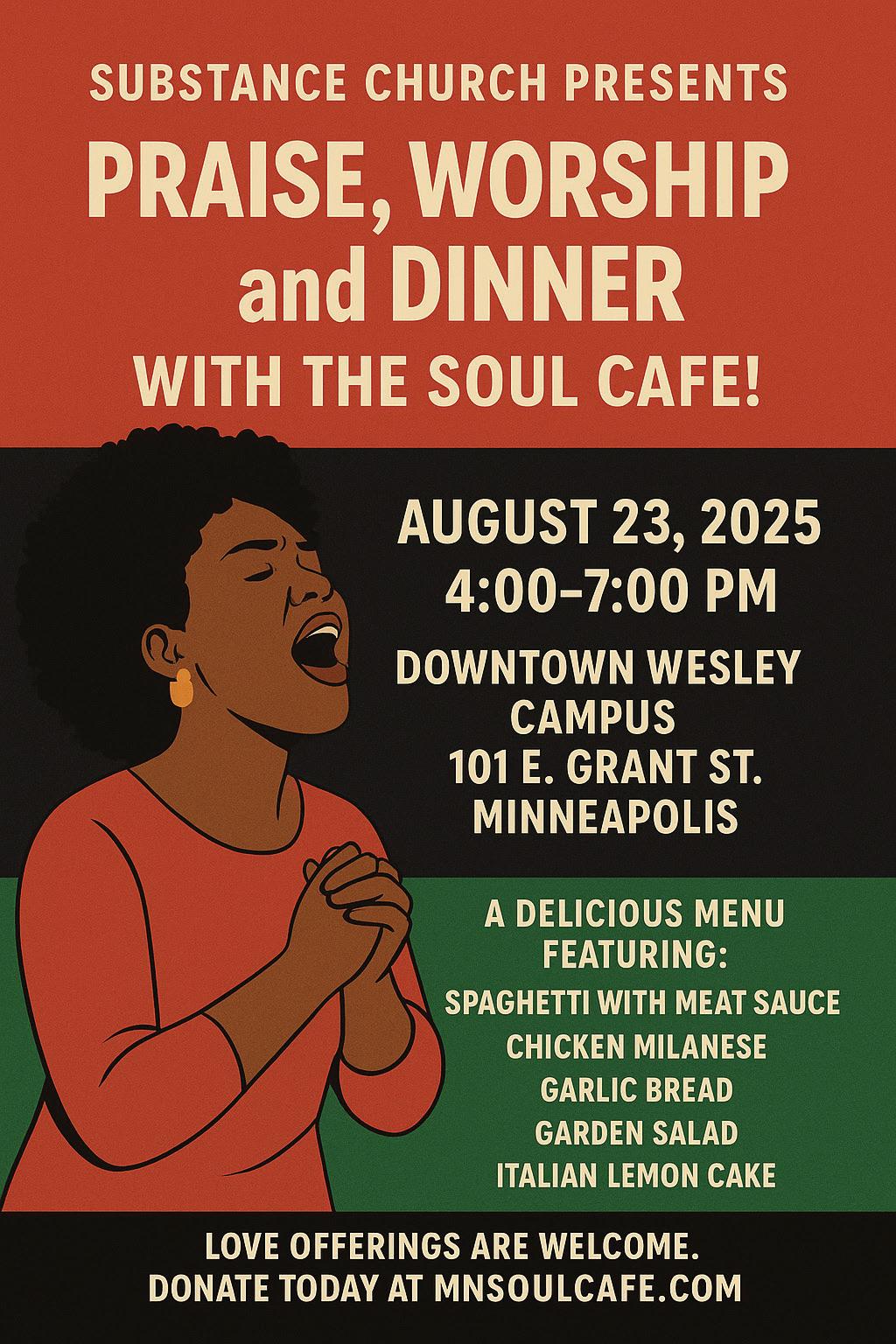
All photos courtesy of Sounds of Blackness


By Zhi Kai H. Vanderford #145673
By Alonzo Graham #212738
In 2024, the Restorative Justice (RJ) program at MCF–Rush City held a fundraiser, something common throughout the Minnesota Department of Corrections (DOC). The RJ program operates statewide, offering groups and classes that help incarcerated individuals understand the impact of crime on victims, families, and communities. It promotes healing, empathy, accountability, and often organizes fundraisers that support victim services and programs. These fundraisers give inmates a rare opportunity to order special food or items not normally available and donate to a good cause. At Rush City, the last RJ fundraiser raised tens of thousands of dollars, one of the most successful on record. But shortly after the money was withdrawn from inmates’ accounts, a memo arrived: refunds were being issued. Why? Because MINNCOR Industries wanted their cut.
Theft from those who have little Yes, the DOC allowed MINNCOR, a state-run prison labor monopoly, to muscle in on funds meant for crime victims. MINNCOR demanded up to 30% of the proceeds. When RJ coordinators couldn’t meet their demand, the fundraiser was canceled. That’s right: A charitable ef-
fort was shut down because someone didn’t pay tribute to the DOC’s corporate arm.
Nothing moves in the Department of Corrections without licking up to the boss, and I’m not talking about Paul Schnell.
This isn’t new. Not long ago, a whistleblower secretly recorded MINNCOR officials bragging about making over $50 million in a single year from inmate labor. That figure doesn’t even include profits from overpriced canteen items, supplies, and equipment sold to incarcerated people at massive markups.
The numbers are staggering. Look up the DOC’s budget: Taxpayers are already footing the bill, yet prisoners are being financially drained on top of it.
Then, on June 11, 2025, a memo from MINNCOR CEO Jeff Lonsky announced that canteen prices would rise by an average of 19% on July 1, blaming “COVID-related inflation.” That would be laughable if it weren’t so harmful.
Worse still, canteen orders placed before July 1 were charged after the price hike, even though the money had already been withdrawn on

No one grows up aspiring to be a prisoner. The threshold for justice and forgiveness seem unattainable. I should know, I’ve been incarcerated 39 years on a 25-to-life sentence. I don’t have the answers yet, but I hope my experiences of time incarcerated promotes dialogue for improvements.
burned bridges. When people leave prison, they are worse off than when they arrived. This becomes a societal problem as prisoners and parolees become a taxpayer drain.
Please Note: New email address for all future ads is ads@spokesman-recorder.com
June 30. This wasn’t inflation. It was theft, a deliberate move to take more from people who have little.
Some numbers:
• A single pair of Pro 5 boxers: $15.77 (up from $9.79)
• Always Ultra pads (with wings): $10.65 (up from $5.77)
• A cheap 15” clear AmpD TV (no speakers): $306 before tax (up from $242.35, worth $50 or less on the street)
• 13” TV: $251.10
3oz Colombian coffee:
$3.67 (up from $2.99)
• 8oz Folgers instant: $12.43 (up from $8.34)
• 6oz Moon Lodge chips: now $2.36, previously $1.42
• 12oz honey: $4.20
• Instant oatmeal (12-pack):
$4.11 (up from $2.63)
All of this without any raise in inmate wages. Not one cent.
One of the most absurd markups is the 9.5x12.5 manuscript envelopes, made by MINNCOR. Once 20¢ each, they now cost 73¢ apiece. These envelopes, used for legal mail, don’t include postage. Just paper. Legal postage costs over a dollar. I used to pay $2.00 for 10; now it’s $7.30. It’s extortion, plain and simple.
Inflation may be real outside prison walls, but MINNCOR’s price hikes have nothing to do with tariffs or global markets. Covid? That’s the excuse. Meanwhile, this monopoly continues to operate with zero oversight and deep political protection.
Why are so many incarcerated Minnesotans becoming diabetic or prediabetic?
Because MINNCOR doesn’t offer affordable healthy options. The DOC food service is heavy on starches and processed carbs. To eat better, you must pay up, and pay a lot. Trying to get an investigation into MINNCOR’s practices is like trying to get Donald Trump to kiss a Mexican baby. But there are people pushing for transparency. One such effort is the End Slavery bill. Look it up. It aims to challenge these exploitative practices.
So I ask: What constitutes a crime? Is it only when someone gets caught?
Accountability shouldn’t depend on status or occupation. It should be universal. And we need our leaders to finally recognize that. A hell of a task; but let’s try. Alonzo Graham (ID# 212738) is currently incarcerated at MCFRush
Most prisoners are parents. I’ve witnessed women come to prison not knowing they are pregnant, then lose custody of their kids. Some moms can’t get released during the mandated time to have their kids returned to them. Dads are usually not able to make any substantial payment of child support from prison, and of course their incarceration brings shame to their intentions to foster a severed relationship.
Most prisoners’ crimes had nothing to do with their parenting; some crimes are connected to attempts at financial support for their kids. Mainly, parenting is an incentive to do better, but the kids get completely cut out of their lives.
When put into prison, most people lose their jobs and homes, and relationships with family members become
There are no wealthy people in prison; prison is a business built on human mistakes and misery. I believe a huge portion of prison abolition is possible by moving prison guards to probation officers, and moving prisoners to parolees, with appeal bond-type legislation.
invested in their community. Additionally, I’d like to negate imprisonment of troubled youth through boot camp and ranch-type programs.
The prison system needs to shrink and become a place of last resort. Drug treatment, mental health professionals and life coaches need to be employed.
Prison is full of broken people that have paid beyond any definition of justice. Family members die, health fails, and their kids call someone else “mom” and “dad.”
I’m a trans male and understand “blood is not always thicker than water.” I don’t have any biological children, but mentor plenty. Kids are devastated by collateral damage caused by arrest.
My vision would include “life coaching” any would-be prisoners as contributing members of society, where they receive treatment, contribute wages to their family and programs, and remain
If justice is about correcting behavior, it is missing the mark. If justice is the equivalent of punishment, then it is served. Punished people are being released worse off than they started, and prison is just a human garbage dump.
Zhi Kai H. Vanderford is a 58-year-old trans man serving a life sentence, with 38 consecutive years of incarceration across California, Oklahoma, and Minnesota’s women’s and men’s prisons. He is believed to be the first female-assigned person in Minnesota to be transferred to a men’s facility without access to gender-affirming surgery, and he identifies as a modern-day Mulan. Zhi Kai is working on his Master’s in Business Administration and seeks parole support at freezhikai.org.
By an MCF-Rush City inmate
I am writing this letter primarily for any and all public safety legislators who may be interested in what type of less-than-legal and harmful activity is going on inside what may one day be the last level 4 prison in the state.
I have been here a little over a year at MCF-Rush City; however, I have been in the state prison system for the last decade and have lived inside all of the highest level prisons in this state, which gives me a unique perspective on the issues relative to each prison, or “correctional facility” as the current terminology goes.
Library” website under the 3/7/2024 report compiled by the D.O.C. themselves. There is even a section at the bottom for contacting the D.O.C. if anyone has questions
Upon reading this yourselves, I would further ask that you carefully read MN State Statute 243.53 “Correctional institutions; occupancy limits of cells.”
Under subdivision b, it states: “Correctional institutions classified by the commissioner as custody level one, two, three or four institutions must permit multiple occupancy, except segregation units, to the greatest extent possible not to exceed the limits of facility infrastructure
briefly give the best solution for this place, which is to expand “housing.” However, the 3/7/2024 report exclusive to MCF-Rush City is more troubling. The solution proposed by the DOC research director is to simply add a few new buildings for health services and “programming,” while doing nothing for our relatively cramped and, I would argue, dangerous living quarters. Let me put this into perspective for those of you unfamiliar with living in a prison for years or decades; step inside a small-sized household bathroom and imagine there being a bed in lieu of a shower. Not the best place for one to live 22-23 hours per day, right? Now imagine another bed above that one with a very violent and unstable individual who may also be a political enemy of yours, whether it is gang-related, prison politics, tribal, etc.
Relative to MCF-St. Cloud, MCF-Oak Park Heights, and even MCF-Stillwater — which is now set to close in the next four years (potentially St. Cloud one day too) — MCFRush City is by far the most troubled prison I have lived in.
This is due to the fact that it is currently at nearly 200% capacity of what it was originally designed for. Combine that with the fact that we are understaffed here and it creates the perfect storm.
Don’t believe me? Well, you don’t have to take my word for it. Anyone can easily find this data at the “Minnesota Legislative Reference
and programming space.”
I’m no lawyer and definitely not a judge, but I can read quite well and I am convinced that once a number of you legislators look into this you will come to the same conclusion.
The report, which was followed up with a February 2025 report by the MN Office of the Ombuds for Corrections titled “Crumbling conditions create crises in Minnesota prisons,” briefly touches on this issue as well as many other solutions for the future of the state prison system.
In the ombuds report from this year, they seem to
Perhaps you understand the point. There have been many rapes and multiple murders in here, not to mention everything in between, solely due to that fact. This is largely not an issue in St. Cloud or Stillwater due to the fact that the majority of cells are single-bed only. Oak Park, being a level 5 prison, is 100% single occupancy. To date, they have had only one inmate murdered at MCFOak Park since it opened. The other level 4 prisons cannot say the same.
The author, an inmate at MCF-Rush City, chooses to remain anonymous. Due to space constraints, the letter has been edited for length but retains its core message about overcrowding and safety concerns at the facility.
Employment & Legals

BILLING@SPOKESMAN-RECORDER.COM
PROBATE
Please Note: New email address for all future ads is ads@spokesman-recorder.com The MSR handles billing digitally. This means you will get e-tears and e-mailed invoices unless you specifically request a hard copy.
“We understand exactly where this league is heading,” said Cloud. “We understand economics and business models.”
When asked during her media appearance before the WASG, Commissioner Cathy Engelbert told reporters, including the MSR, “We had candid dialogue. Communication is important. We’ve been through these negotiations many times.
a lot of hard work to be done on both sides to get it done.
“Would we like to get it done [before the start of next season]?” asked Engelbert.
“Yes. We’ve got some room to continue negotiations.”
“There has to be a common ground, but what’s been presented is a slap in the face,” complained Cloud.
As Banham pointed out, she and the players can’t allow social media uproar chock full of misinformation to detour them from their ultimate goal — a new CBA. And both sides don’t want a work stoppage, either.
“We know we deserve

“I want a lot of the same things the players want,” stressed the Commish. “I’m still optimistic that we’ll get something done that will be transformational. Obviously, there’s
what the league should give up,” she concluded.
Charles Hallman welcomes reader comments to challman@ spokesman-recorder.com.
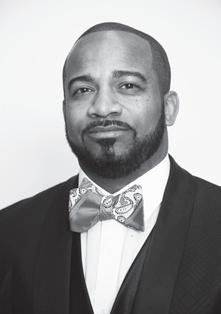


SOE
Continued from page 10
From coach to scout
Shelley Patterson has been coaching in the WNBA virtually the entire league’s existence. She was an assistant in Houston (1999) two years after the league started; then Indiana (2000-03), Phoenix (2004), Los Angeles (2005), Seattle (2006-09), Minnesota (2010-19), New York (2020-21), and Washington (2022-24).
Patterson earned championship rings in Houston (1), Seattle (1) and Minnesota (4), as well as a reputation for being a ‘shot doctor,’ helping players in their shooting mechanics.
“It’s been a lot of fun,” said Patterson, who also was a head coach of the Chicago Blaze of the National Women’s Basketball League in 2005. This season she was named the Mystics’ head of domestic scouting.
“I love what I do,” she said. “So whenever you’re working
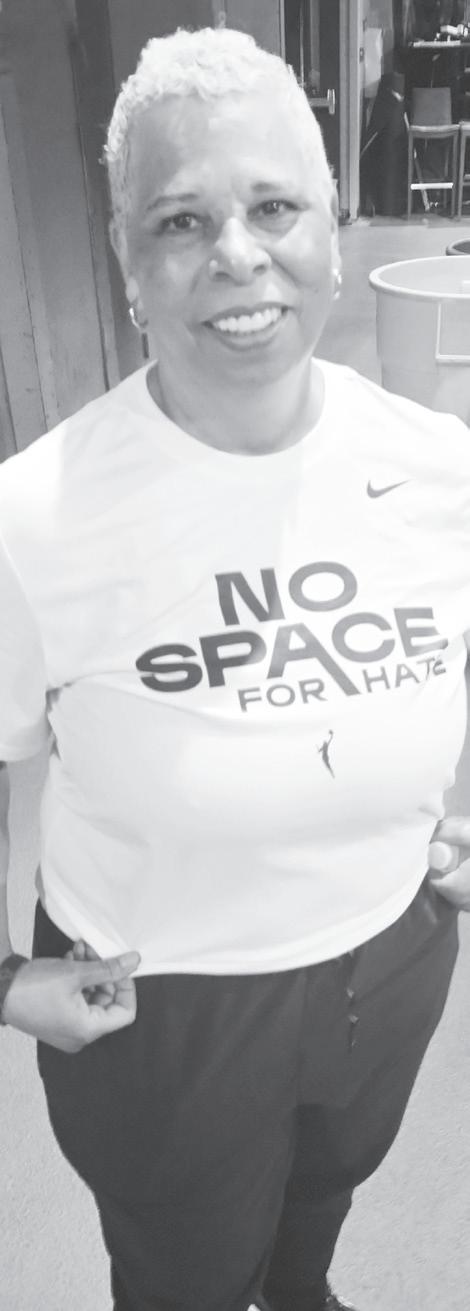
with great people and great young kids, you gotta keep going.”
Charles Hallman welcomes reader comments to challman@ spokesman-recorder.com.
EQUITY
Continued from page 10
pointed out.
Ramsey recently released two papers, one on colleges complying with Title IX in light of the House settlement, and another urging the NCAA to set up policies to address flaws in the settlement.
Reportedly, University of Minnesota football will receive around 75%, and men’s and women’s basketball, men’s hockey and volleyball will share the remaining 25%.
“It doesn’t necessarily require that things be equal, like dollar for dollar, but it does have to be equitable.”
“I think that one of the main things that is important for Title IX is ensuring that the revenue share payments are provided in such a way that it complies with Title IX,” advised Ramsey. “You use the word ‘equitable,’ and that’s what I tell people when we talk about Title IX. It doesn’t necessarily require that things be equal, like dollar for dollar, but it does have to be equitable.”
Are we seeing in this new system a built-in inequity? What about Gopher women’s hockey, one of the best in the nation and historically competing for national championships? Yet football, which hasn’t won a national title since 1960, and hasn’t won a Big Ten title, gets the lion’s share of the Gopher money.
“We’re trying to make sure that there are equitable opportunities for both men’s and women’s athletics, and that includes revenue sharing,” stressed Ramsey.
Charles Hallman welcomes reader comments to challman@ spokesman-recorder.com.

Graphic courtesy of Threads
Shelley Patterson Photos by Charles Hallman



BA talks between the WNBA and its players are still ongoing, but reportedly the two sides are as close as the East Coast and the West. The players opted out of the current collective bargaining pact in October, and it is set to expire on Oct. 31.
After an in-person meeting with an estimated 40 players in attendance with league officials at the recent All-Star Game in Indianapolis, the rank and file boldly expressed its displeasure about the negotiations by wearing “Pay Us What You Owe Us” pregame

his week’s Fab Four photos feature a week in the WNBA in which the Minnesota Lynx suffered their first home loss to the Atlanta Dream (90-86) on Sunday, July 27, and a rebound victory over the defending champion New York Liberty (100-93) on Wednesday, July 30.
In the first game, Brittany Griner led the Dream with 22
With
Sports
W valuations
up, players demand their fair share
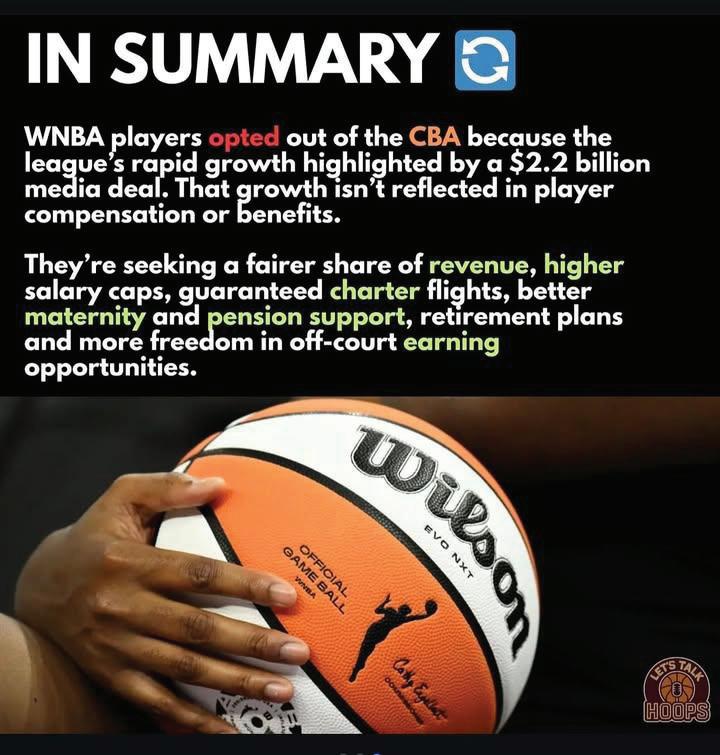
points. Jordan Canada had 18, Allisha Gray and Shatori Walker-Kimbrough chipped in 12 each, and Naz Hillmon chipped in seven points and grabbed nine rebounds.
Napheesa Collier finished with 32 points and eight rebounds to lead the Lynx.
Three days later Collier led the Lynx with 30 points, Kayla McBride 24, Alanna Smith 12, and Bridget Carleton and Natisha Hiedeman with 10 each. The Liberty were led by Sabrina Ionescu’s 31 points. Isabelle Harrison had 15 off the bench, Marine Johnnes added 14, and Natasha Cloud and Jonquel Jones contributed 12 apiece.
Dr. Mitchell Palmer McDonald welcomes reader comments to mcdeezy05@gmail.com.

shooting shirts. The action drew both praise and brickbats afterwards.
“As a collective, we don’t really care,” declared Chicago Sky veteran guard Rachel Banham.
“I think we have a huge, huge responsibility to make a transformational CBA, not only for our generation now but the next generation that will come into this league,” replied New York guard Natasha Cloud to a reporter’s question during an All-Star media session, including the MSR, in Indy last month.
Are the W players asking too much? Their reported demands include better pensions, better revenue sharing,
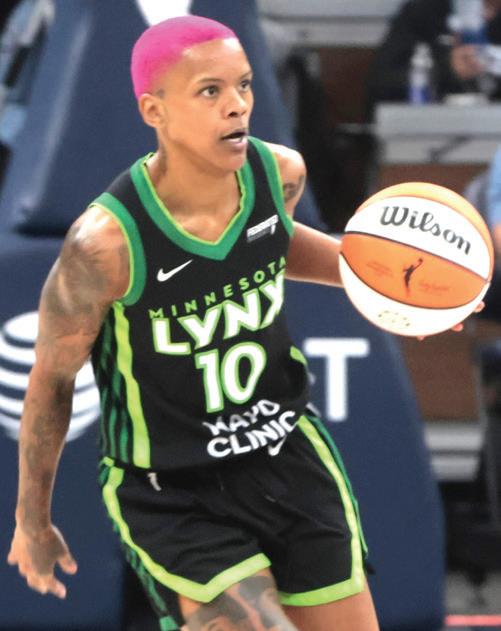
New Mystics head coach ‘humble but enthusiastic’ Sharing
This occasional series will highlight Black coaches at all levels of sport. This week: Washington Mystics HC Sydney Johnson and veteran assistant Shelley Patterson.
ne of the WNBA’s youngest teams this season is the Washington Mystics, whose average age is 24.72. They will be in town this weekend (August 8) to play Minnesota, the league’s fourth-youngest club (25.75).
“We are the youngest team,” first-year Head Coach Sydney Johnson said in correcting us when asked the last time his Mystics were in town July 3 for a 92-75 loss to the Lynx.
“We’re trying to win games, but we’re looking also for those small wins every day.”
Although this is his first

year as a WNBA head coach, Johnson is a seasoned coaching veteran with 25 years of basketball experience. He and Mystics GM Jamila Wideman were hired last December. She joined Washington after six years at the NBA League office, most recently as senior VP of player development.
Johnson is in his second overall season in the W — he was a Chicago Sky assistant coach last season, his first in the league. After nearly a dozen years of playing in college (Princeton, 1993-97) and in the pros (overseas with four clubs, 1997-2004), Johnson transitioned into coaching, first as an MBB assistant at Georgetown (2004-07) before head coaching stints at Princeton (2007-11) and Fairfield (2011-19), and associate HC at Air Force (2020-21).
After almost three years away from the game, Johnson pointed out that it was time to return to the bench in some capacity and accepted the offer to join then-Chicago head coach Teresa Weatherspoon’s staff last summer.
“I was fortunate to get an opportunity in Chicago as an assistant coach,” continued Johnson. “I did want to get back into coaching. I’d been out for a couple of years doing some analytics for college basketball teams.
“I really wanted to get back on the bench, and that experience [last season] was wonderful,” he admitted.
Johnson is one of three Black HCs in the league this season, and the JohnsonWideman head coach-GM
tandem currently is the only such Black duo in the W.
“I feel blessed to have a partner in that regard. I would say Jamila’s perspective and frame of reference [she is a former W player, 1997-2000] on how we need to support women — Black folks, all folks, young folks — is something that I truly appreciate, and it shows up in how we show up for our players.”
“Whether it’s in coaching roles and general manager roles, agent roles, in media, there’s a need for representation.”
On the importance of Blacks in coaching and key front office roles, “This is a women’s league dominated by Black and brown women who have been playing at a high level for quite some time now,” stressed Johnson. “Yeah, I would say there’s still room to grow those [positions] — it’s 2025.
“So, whether it’s in coaching roles and general manager roles, agent roles, in media, there’s a need for representation,” he said. “I’ll just say in my role I am completely cognizant of I’m here to serve and support and illuminate. So, I’m very aware of where I’m positioned and humbly but enthusiastic about being here.”
and a higher salary cap among other issues.
A recent Sportico report showed the WNBA has seen record growth in the last two years. The average W team is now worth $269 million, “a 180% increase, which is more than double the previous biggest year-over-year gain for a major sports league,” wrote Kurt Badenhausen on June 24, which was published almost a month before the players’ meeting with the league.
“We all come to push for everything that we earned,” added Cloud. “Sometimes I think our intelligence is insulted in a lot of ways. We are more than just basketball players.”
Badenhausen’s piece also pointed out, “Next year kicks off the league’s new media deals, which are expected to generate $260 million in annual revenue.” He listed
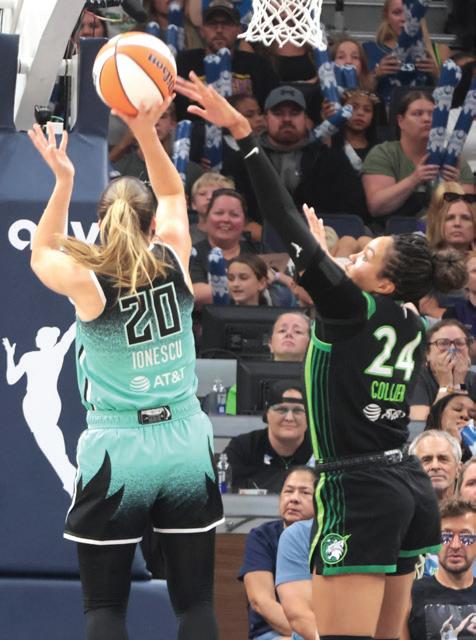
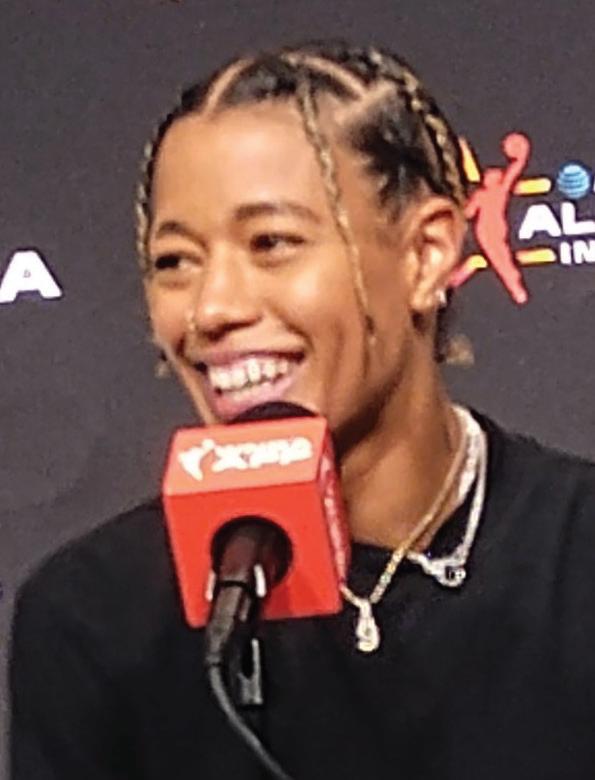
By Charles Hallman Sports Columnist
e are now in uncharted waters regarding college sport.
Last month, Division I colleges and universities began paying their athletes from a $20.5 million pot per school in additional benefits besides scholarships.
This cap, based on a specified percentage (22%) of the average athletics-generated revenues of the Power 5 schools, will vary over the next 10 years, and is projected to reach as high as $33 million per school by year 10.
The new college sport revenue sharing is the result of the House v. NCAA settlement, but schools aren’t told how they can distribute these funds among or within their sports programs, only that the money goes to college athletes. This in itself can open yet another can of worms. College athletes, who have historically been on the outside looking in while their schools rake in millions solely on their athletic performances, are finally getting their due. Still there are those who subscribe to the archaic amateur belief that college players getting a scholarship should be enough.
We saw this misguided belief promoted once again last week after a presidential executive order was issued that aimed to regulate how NIL is paid to athletes. Since 2021, college athletes have been able to profit off their name, image and likeness, and get paid legally via third parties.
We talked to Kassandra Ramsey, president of The Drake Group, a nonprofit ad-

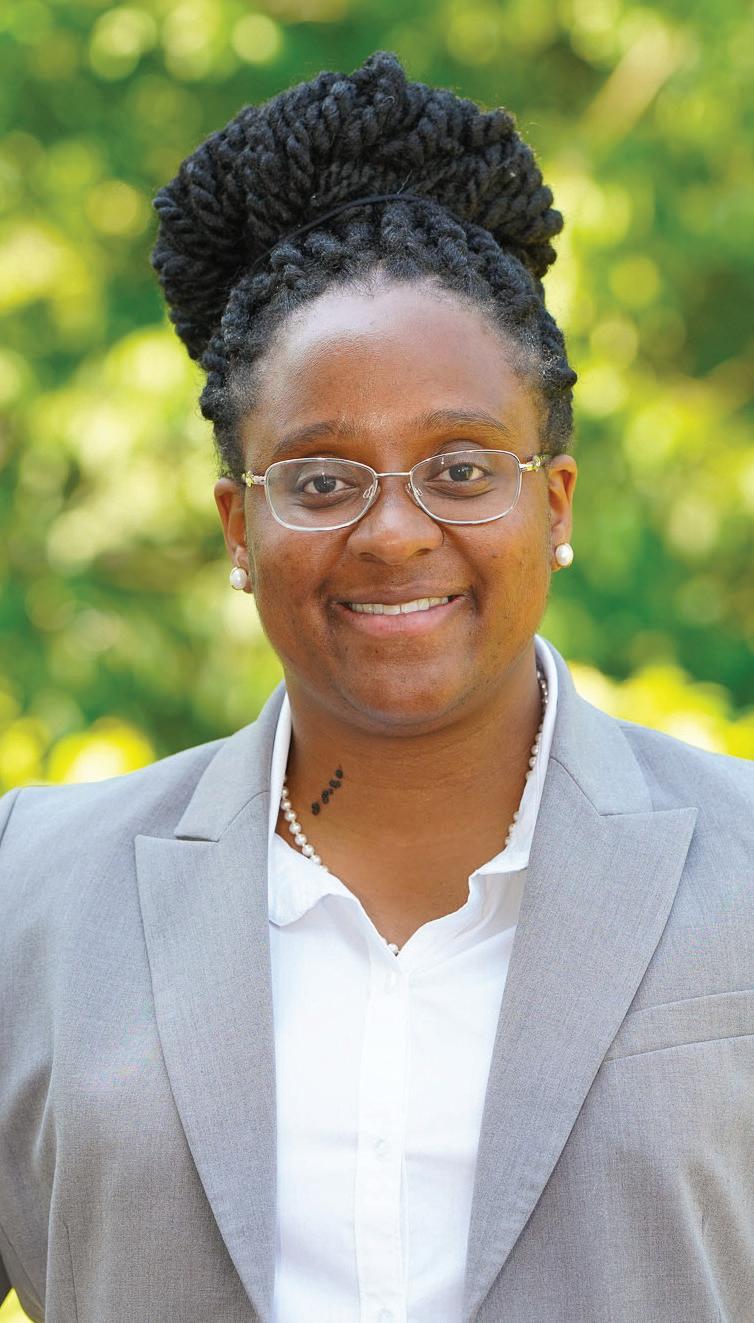
vocacy organization founded in 1999 by a former Drake University professor that tries to better educate U.S. Congress and higher education policymakers about critical issues in college athletics. The think tank is composed of academic types, experts in sports management, sports economics, and sports law.
“I would say it wasn’t totally unexpected,” said Ramsey of
the exec order. “I think for a lot of people like myself who’ve been studying the industry, it’s an executive order. It’s not really indicative of what may actually come to be or really has no real enforcement power.”
Ramsey has been president since 2024. She is an attorney by trade.
“When I was in law school, I wrote a paper about college athletics because I always thought that the system was kind of fundamentally wrong,” she recalled. “I wrote about advocating for college athletes rights…
“I knew that athletes, particularly athletes of color, would need resources and access to people to help them understand these concerns and why it’s important, and understand the [NIL] deals that they’re signing.
“I really just have a passion, just to help athletes and their parents to be able to use these opportunities to set themselves up” for building generational wealth, Ramsey

Minnesota Lynx guard Napheesa Collier attempts to block New York Liberty guard Sabrina Ionescu’s shot.
Minnesota Lynx guard Natisha Hiedeman covering New York Liberty guard Natasha Cloud
Minnesota Lynx guard Courtney Williams
Minnesota Lynx guard Kayla McBride and Atlanta Dream forward Naz Hillmon (with ball)
Photos by Dr. Mitchell Palmer McDonald
the Minnesota Lynx seventh ($240 million) among the 13 WNBA clubs’ valuations. Overall, among the six North American sports leagues, the WNBA is at the top, 12 times 2024 revenue, followed by NBA (11.9), MLS (9.4), NFL (9.3), NHL (7.7) and MLB (6.6).
■ See VIEW on page 9
Natasha Cloud Photo by Charles Hallman
Graphic courtesy of Threads
Coaching While Black
Sydney Johnson
Photos by Charles Hallman
Kassandra Ramsey Submitted photo
Courtesy
